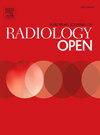核磁共振成像上膝关节后内侧半月板与关节囊交界处的可变性:斜坡病变成像诊断的陷阱
IF 2.9
Q3 RADIOLOGY, NUCLEAR MEDICINE & MEDICAL IMAGING
引用次数: 0
摘要
目的斜坡病变是指发生在前交叉韧带缺失的后角、内侧半月板和后内侧关节囊交界处的损伤。我们试图将文献中对MRI斜坡病变(后内侧半月板和相邻包膜之间的液体信号)描述的共识应用于一般人群,以确定这种“异常”在常规MRI上出现的频率,并帮助澄清其特异性。材料和方法由2名放射科医生回顾性回顾了100例连续的膝关节MRI研究,并以二元方式以斜坡病变或正常外观为特征。如果存在斜坡病变,则根据Thanaut等人的分类对病变进行再分类。记录患者的年龄、侧卧、性别、临床指征和MRI辅助表现。结果100例膝关节中有35例(35 %)的MRI显示斜坡病变,31/35例(88.6% %)与Thanaut等人的1型最一致。35例坡道病变中仅有7例(20% %)ACL功能不全。年龄(p = 0.00044)、右侧偏侧(p = 0.019)、女性(p = 0.029)与该病变有统计学相关性。与近期创伤的临床病史无关联(p = 0.2399)。结论后角内侧半月板半月板结缔组织的外观可能比文献中讨论的斜坡病变更多样。最值得注意的是,在接受膝关节MRI检查的患者中,后角内侧半月板和邻近的后内侧囊之间的积液并不罕见,而且似乎是非特异性的。本文章由计算机程序翻译,如有差异,请以英文原文为准。
Variability of the posteromedial meniscocapsular junction of the knee on MRI: Pitfall to imaging diagnosis of ramp lesions
Objective
A ramp lesion describes injury at the junction of the posterior horn medial meniscus and posteromedial joint capsule occurring with anterior cruciate ligament deficiency. We sought to apply the consensus of the literature’s description of a ramp lesion on MRI (fluid signal interposed between the posterior medial meniscus and adjacent capsule) to a general population to determine how often this “abnormality” is present on routine MRI and help clarify its specificity.
Material and methods
100 consecutive MRI knee studies were retrospectively reviewed by 2 radiologists and in binary fashion characterized as either having features of a ramp lesion or normal appearance. If a ramp lesion was present, the lesion was subclassified according to the Thanaut et al. classification. Patient age, laterality, sex, clinical indication, and ancillary findings on MRI were recorded.
Results
Thirty-five of 100 (35 %) knees had MRI findings suggesting a ramp lesion with 31/35 (88.6 %) most consistent with a Thanaut et al. type 1. Only 7 of the 35 (20 %) with ramp lesion had ACL insufficiency. Age (p = 0.00044), right laterality (p = 0.019), and female sex (p = 0.029) were statistically associated with this lesion. There was no association with clinical history indicating recent trauma (p = 0.2399).
Conclusion
The appearance of the meniscocapsular junction of the posterior horn medial meniscus may be more varied than the literature discussing ramp lesions suggests. Most notably, fluid interposed between the posterior horn medial meniscus and adjacent posteromedial capsule is not uncommon in those undergoing knee MRI and appears to be nonspecific.
求助全文
通过发布文献求助,成功后即可免费获取论文全文。
去求助
来源期刊

European Journal of Radiology Open
Medicine-Radiology, Nuclear Medicine and Imaging
CiteScore
4.10
自引率
5.00%
发文量
55
审稿时长
51 days
 求助内容:
求助内容: 应助结果提醒方式:
应助结果提醒方式:


